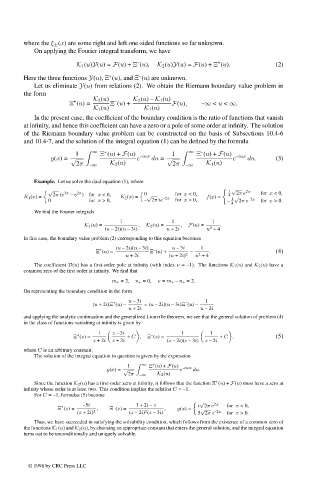Page 533 - Handbook Of Integral Equations
P. 533
where the ξ ± (x) are some right and left one-sided functions so far unknown.
On applying the Fourier integral transform, we have
+
–
K 1 (u)Y(u)= F(u)+ Ξ (u), K 2 (u)Y(u)= F(u)+ Ξ (u). (2)
–
+
Here the three functions Y(u), Ξ (u), and Ξ (u) are unknown.
Let us eliminate Y(u) from relations (2). We obtain the Riemann boundary value problem in
the form
K 2 (u) K 2 (u) – K 1 (u)
+ –
Ξ (u)= Ξ (u)+ F(u), –∞ < u < ∞.
K 1 (u) K 1 (u)
In the present case, the coefficient of the boundary condition is the ratio of functions that vanish
at infinity, and hence this coefficient can have a zero or a pole of some order at infinity. The solution
of the Riemann boundary value problem can be constructed on the basis of Subsections 10.4-6
and 10.4-7, and the solution of the integral equation (1) can be defined by the formula
+ –
1 ∞ Ξ (u)+ F(u) –iux 1 ∞ Ξ (u)+ F(u) –iux
y(x)= √ e du = √ e du. (3)
2π –∞ K 2 (u) 2π –∞ K 1 (u)
Example. Let us solve the dual equation (1), where
√
√ 1 2x
2x
2π (e 3x – e ) for x <0, 0 for x <0, 2πe for x <0,
K 1 (x)= K 2 (x)= √ –2x f(x)= 4 √
0 for x >0, – 2πie for x >0, – 1 2πe –2x for x >0.
4
We find the Fourier integrals
1 1 1
K 1 (u)= , K 2 (u)= , F(u)= .
2
(u – 2i)(u – 3i) u +2i u +4
In this case, the boundary value problem (2) corresponding to this equation becomes
(u – 2i)(u – 3i) u – 3i 1
–
+
Ξ (u)= Ξ (u)+ – . (4)
u +2i (u +2i) 2 u +4
2
The coefficient D(u) has a first-order pole at infinity (with index ν = –1). The functions K 1 (u) and K 2 (u)havea
common zero of the first order at infinity. We find that
m + =2, n + =0, ν = m + – n + =2.
On representing the boundary condition in the form
u – 3i 1
–
+
(u +2i)Ξ (u) – =(u – 2i)(u – 3i)Ξ (u) –
u +2i u – 2i
and applying the analytic continuation and the generalized Liouville theorem, we see that the general solution of problem (4)
in the class of functions vanishing at infinity is given by
1 z – 3i 1 1
+
–
Ξ (z)= + C , Ξ (z)= + C , (5)
z +2i z +2i (z – 2i)(z – 3i) z – 2i
where C is an arbitrary constant.
The solution of the integral equation in question is given by the expression
+
1 ∞ Ξ (u)+ F(u)
y(x)= √ e –iux du.
2π –∞ K 2 (u)
+
Since the function K 2 (u) has a first-order zero at infinity, it follows that the function Ξ (u)+ F(u) must have a zero at
infinity whose order is at least two. This condition implies the relation C = –1.
For C = –1, formulas (5) become
√
–5i 1+2i – z i 2πe 2x for x <0,
+
–
Ξ (z)= , Ξ (z)= , y(x)= √
2
(z +2i) 2 (z – 2i) (z – 3i) 5 2πe –2x for x >0.
Thus, we have succeeded in satisfying the solvability condition, which follows from the existence of a common zero of
the functions K 1 (u) and K 2 (u), by choosing an appropriate constant that enters the general solution, and the integral equation
turns out to be unconditionally and uniquely solvable.
© 1998 by CRC Press LLC
© 1998 by CRC Press LLC
Page 515

